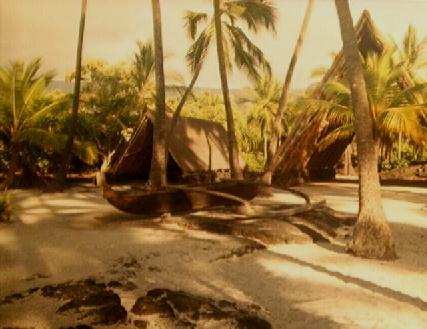The inside of the wall was quite different from the outer section,
entering through a passage in the wall you will first see several fish
ponds, both natural and manmade.  Fishermen would keep these ponds stocked with the favorite fish of the Ali'i (royalty) and
the Kahuna's (priests). As harsh as it may sound, not having the desired
fish for the Chief's meal could cost someone their head.
Fishermen would keep these ponds stocked with the favorite fish of the Ali'i (royalty) and
the Kahuna's (priests). As harsh as it may sound, not having the desired
fish for the Chief's meal could cost someone their head. 

Besides the fishponds and the residences of the Ali'i and Kahuna's
you could find open sheds 
where canoes
were built. These canoes  were carved from a single trunk of the Koa tree, a hard (and heavy) native
tree. The canoe
were carved from a single trunk of the Koa tree, a hard (and heavy) native
tree. The canoe  was the workhorse of the
hawaiian community, used for everything from waging war to transporting goods around the island. Nearby is the royal canoe landing at Keone'ele Cove
was the workhorse of the
hawaiian community, used for everything from waging war to transporting goods around the island. Nearby is the royal canoe landing at Keone'ele Cove 
now a favorite feeding ground for the Honu  the green sea turtle.
the green sea turtle.
To the North of the park is Honaunau bay which boasts some of the finest scuba diving in the area. There are also picnic
facilities although on weekends it is usually very crowded, driving through the park past the information center you can take a dirt road to
another picnic spot with palm trees and concrete bbq pits and picnic tables, while usually not as crowded as the bay
it is still a very popular spot with local families on the weekends.
Image used in background border courtesy of

